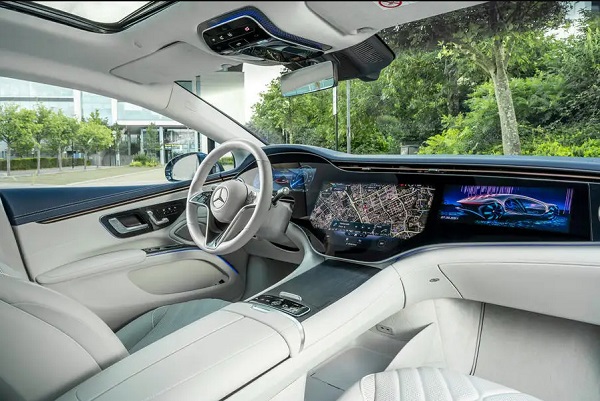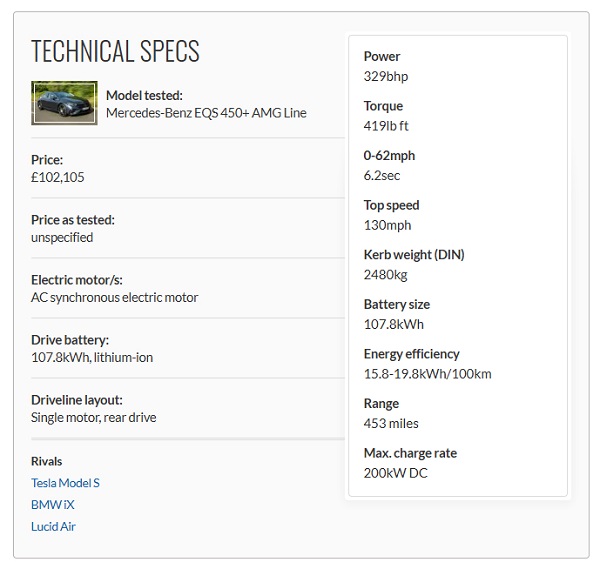More than just a rival to the electric S-Class, this offers an initial glimpse into the future of every upcoming Mercedes.
The Mercedes EQS is not only the brand’s first comprehensive, all-in electric vehicle, but this drive serves as an early look at the newly electrified Mercedes-Benz S-Class – which would be exciting on its own.
Additionally, it’s a preview of the technology that will influence all future Mercedes models, meaning every potential customer of the brand should be eager to continue reading.
This is also our first opportunity to experience this vehicle in the UK, albeit still in a late-stage prototype and too early for a final pricing list.
As such, our focus is on verifying whether the initial 4.5-star rating from our prior test was fair or overly optimistic, rather than determining if that last half star is attainable. Any aspirations for that highest accolade will need to be postponed until more comprehensive testing and complete specification details are unveiled next month.
Set aside any biases for a moment: whatever your expectations based on the images, believe me, your eyes will widen shortly after you approach the EQS, pause as its door opens automatically upon detecting your arrival, and settle into the wonderfully – and fittingly – opulent seat.
Is. That. For. Real? Spanning 141cm from side to side, it’s the Hyperscreen – an optional three-in-one display that stretches across the dashboard, taking the place of two standard (though still sizable) screens. If visual appeal is your primary criterion for a car, choose this one. Captain Kirk would likely faint from all the excitement.
However, there is an important downside to its impressive size. While it is relatively easy to navigate when stationary, we found it more effective to utilize Mercedes’ remarkably efficient voice control rather than our hands, both to keep our eyes on the road and to avoid leaving smudges from our uncertain attempts. Familiarity would surely improve the experience. Moreover, despite the dull weather, there were enough occasional reflections to make us long for simpler designs.
Thus, the lasting impression of genuine quality left by the EQS is its remarkable capability on the road. It offers astounding speed, even in this less powerful variant, provides impressive balance and control despite nearing 2.5 tonnes in weight, and boasts an astonishing, though likely slightly optimistic, official range of 484 miles, aided by its sleek profile – said to be the most aerodynamic ever on a production vehicle. A rapid charge from 10-80% can be achieved in as little as 30 minutes, though a more typical 50kW charger will require approximately an hour and a half.

All of this is, naturally, experienced in near silence, aside from some wind noise at higher speeds, and in the utmost comfort (the supportive, massaging seats and ample space throughout stand out). It is also impressively nimble, with rear-wheel steering enhancing its maneuverability at lower speeds and stability at higher velocities. In these aspects, it is immersively and seductively luxurious.
Nevertheless, the EQS cannot completely defy the laws of physics. Although the direct and genuinely responsive steering effectively masks this large vehicle’s size and the body control is exceptional on all but the most uneven surfaces, some of the UK’s more substantial, repetitive bumps simply cannot be smoothed over, while the tires lose grip earlier than one might expect in a regular S-Class if you enter a turn or roundabout too aggressively.
Is this potentially the world’s most capable electric vehicle at the moment? It could be. However, does that guarantee it a five-star rating? The decision is yet to be made.
The two most apparent trade-offs are the functionality of the large display and the performance limitations stemming from the substantial battery weight.
These issues are not exclusive to Mercedes, and the brand has likely excelled more than anyone else in addressing both – particularly for a luxury vehicle of such diverse capabilities, though it may not match the dynamic performance of the more specialized Porsche Taycan.
Aside from that, the EQS embodies all the qualities deserving of the S-Class title. It truly provides a magnificent, luxurious travel experience in every other aspect – and serves as an enticing glimpse into the exciting future ahead. While it may not be perfect, there’s a solid chance it could be as close as we can anticipate for the time being.
The Mercedes-Benz S-Class has long been esteemed as the standard-bearer of luxury for the brand, and the all-electric 2025 EQS presents an equally lavish experience—but with a body so gently curved that it appears to have been slightly melted by the sun. It can come with either a single motor and rear-wheel drive or two motors and all-wheel drive, allowing for either an enhanced driving range or up to 516 horsepower for top-tier acceleration. Regarding range, even the least efficient EQS580 version managed to cover over 350 miles in our highway range assessment—an impressive feat.
Tech enthusiasts will find much to appreciate within the EQS’s interior, featuring three screens incorporated into the dashboard along with numerous connectivity and driver-assistance tools built into the design. Our main criticisms of the EQS involve its uninspiring driving characteristics and its vague, disconnected brake pedal sensation. If you’re looking for a smooth, quiet ride, the EQS certainly provides that. However, its competitors—including the BMW i7 and the Lucid Air—offer similar elegance and superior driving dynamics, making the EQS less attractive.
What’s new for 2025?
For 2025, the EQS has received an updated front design that replaces the imitation grille and inset logo with a three-bar style and a prominent hood ornament, aiming to make the electric sedan resemble the traditional gas-powered S-Class more closely. However, a more significant improvement lies under the EQS’s floor: Mercedes has upgraded last year’s 108.4-kWh battery to a larger 118.0-kWh variant to enhance the driving range. Adjustments to the vehicle’s regenerative braking system are also expected to improve the estimated driving range, according to the company. Additionally, the interior has been slightly enhanced with more chrome details and contrasting stitching on the rear seat cushions. This year, the top-tier Pinnacle model can be equipped with an Executive Interior package that introduces a reclinable rear seat and a front passenger seat that can fold towards the dashboard to allow for increased rear-seat space.
The EQS sedan comes in three models featuring three different powertrains and trim levels. We suggest the EQS450 4Matic in the Pinnacle trim. The sedan is filled with luxury, convenience, and safety features, down to plush rear headrests with a comfortable pillow topper. This year, that model produces the same 335 horsepower as the rear-wheel-drive variant, but its additional motor boosts the torque to 590 pound-feet. The estimated range with all-wheel drive is only ten miles shorter than that of the rear-wheel-drive sedan, although the new Intelligent Disconnect feature could help minimize that difference.
EV Motor, Power, and Performance
The rear axle of the EQS450+ is equipped with a single motor that generates 335 horsepower and 419 pound-feet of torque. The EQS450 4Matic incorporates an additional electric motor on the front axle, providing all-wheel drive. While the combined horsepower remains at 335, the torque increases to 590 pound-feet. The EQS580 4Matic boasts a total of 516 hp and 611 pound-feet of torque. All EQS models are built on an adaptive air suspension system and come with wheel sizes between 19 and 21 inches. The standard rear-axle steering can adjust the rear wheels up to 10 degrees to minimize the turning radius. Given that the EQS measures 207.3 inches in length—roughly three inches shorter than a Chevy Tahoe—rear-wheel steering enhances the sedan’s maneuverability in confined spaces and boosts stability at higher speeds. Our testing revealed that this luxury sedan offers the serene and smooth ride characteristic of a top-tier electric Mercedes. However, it’s less composed around town due to the brake pedal feeling disconnected in our test vehicle. We will assess whether the new braking system resolves our concerns when we receive a 2025 model for testing.
0–60-MPH Times
During our tests, the EQS450+ reached 60 mph in 5.4 seconds, while the more powerful EQS580 achieved 60 mph in merely 3.7 seconds.
Range, Charging, and Battery Life
Every 2025 EQS variant features a lithium-ion battery pack with a usable capacity of 118.0 kWh, which is an enhancement over last year’s model. Although the EPA has yet to revise its range estimates for the 2025 EQS, Mercedes indicates that the upgraded battery and modifications to the regenerative braking system should lead to an approximate 11 percent increase in driving range. This suggests that the most efficient model—the EQS450+—could offer a driving range of up to 390 miles per charge. With a fast-charging ability of 200 kW, every EQS can charge its battery from 10 to 80 percent in just 31 minutes. When utilizing a 240-volt Level 2 charger, recharging from 10 to 100 percent takes 11.5 hours. In our 75-mph highway fuel-economy testing route, which forms a part of our comprehensive testing process, we noted an impressive 350 miles of range from the EQS580 with the older and smaller battery pack. While we anticipate improvements for the 2025 model, we have yet to test it.
Fuel Economy and Real-World MPGe
The EPA projects that the base EQS450+ will offer 98 MPGe in both city and highway driving. The EQS450 4Matic, which features an additional electric motor on the front axle, experiences a decline to 91 MPGe in the city and 93 on the highway. Interestingly, the highest-output EQS580 4Matic trim displays greater efficiency than the EQS450 4Matic, achieving a combined rating of 93 MPGe—which is impressive for a luxury sedan that produces 516 horsepower. When we have the opportunity, we’ll take the 2025 EQS on our 75-mph highway fuel economy route and provide an update on its real-world fuel economy results. For further details on the EQS’s fuel efficiency, refer to the EPA’s website.
Interior, Comfort, and Cargo
It’s safe to assume that Mercedes hasn’t forgotten how to design an S-Class—or its electric counterpart—simply because the powertrain has transitioned from gasoline to electric. The interior finishes meet every expectation and create a comfortable environment filled with advanced technology. Even the basic EQS450+ includes features such as LED headlights, air suspension, a panoramic roof, augmented video navigation that overlays directional arrows on the map for lane and turn identification, Burmester 3D audio, wireless Android Auto and Apple CarPlay, cabin climate preconditioning, adaptive cruise control, active park assistant, and 64-color ambient lighting, among numerous other features. Additionally, there is a standard 56-inch-wide Hyperscreen, effectively three screens in one, transforming the entire instrument panel into a glass display. The cabin offers ample space suitable for NBA players as well. With a completely flat floor and an extended 126.4-inch wheelbase, the EQS boasts an expansive interior. Its generous cargo space is an added benefit, thanks to its large hatchback design.
Infotainment and Connectivity
The EQS is equipped with a fingerprint reader that activates personalized driver profiles, the “Hey Mercedes” voice-command system, and augmented-reality navigation displayed in the head-up unit. Each version also comes with six USB-C ports distributed throughout the interior and Burmester sound system. The MBUX infotainment software from Mercedes operates on the standard Hyperscreen. This display features a 12.3-inch digital gauge cluster, a 17.7-inch central touchscreen, and a 12.3-inch touchscreen for passengers, all covered by a seamless glass panel that creates the illusion of a single large screen. Future over-the-air (OTA) updates for models with the Entertainment Package Plus will introduce features like the YouTube web application and Dolby Atmos surround sound.
Safety and Driver-Assistance Features
The 2025 EQS is loaded with standard driver-assistance technology, including adaptive cruise control and self-parking features. To find more details regarding the EQS’s safety performance, refer to the National Highway Traffic Safety Administration (NHTSA) and Insurance Institute for Highway Safety (IIHS) websites. Notable safety features include:
- Standard automated emergency braking with pedestrian recognition
- Standard lane-departure warning along with lane-keeping assist
- Standard adaptive cruise control that includes a lane-centering function
Warranty and Maintenance Coverage
Mercedes’ limited and powertrain warranties are on par with those offered by other German brands, although they don’t stand out in terms of specifics. Additionally, there is no complimentary maintenance, a benefit provided by BMW.
- Limited warranty spans four years or 50,000 miles
- Powertrain warranty also covers four years or 50,000 miles
- Electrical components are protected for 10 years or 155,000 miles
- No complimentary scheduled maintenance is included
Is the Mercedes EQS a good car?
There are numerous sporty, high-priced electric vehicles available, including Tesla’s Model S, the Porsche Taycan, and the Audi e-tron GT, yet the Mercedes-Benz EQS stands out as the first truly luxurious electric vehicle. It merges outstanding cabin quality and comfort with the silent operation that you expect from an electric vehicle.
If aesthetics are a priority, the EQS certainly makes an impression with its design. Unlike the latest S-Class, which has a conventional three-box sedan silhouette, the EQS features a nearly arch-shaped profile, where the roof flows seamlessly from the front wheels to the rear, with almost no visible hood.
Additionally, it has a hatchback design, offering more versatility compared to the S-Class, which is exclusively sedan. It is filled with remarkable, state-of-the-art technology, making it feel almost like a science experiment on wheels—though a highly luxurious one.
You will find a substantial battery that provides the EQS with an impressive range of up to 453 miles, along with the ‘Hyperscreen.’ This concept takes touchscreen technology to its extremes; a full-width display that consists of three screens enclosed beneath one continuous piece of glass that spans across the entire dashboard. The rest of the cabin is equally luxurious, featuring soft materials and sleek metallic accents throughout.
Moreover, the vehicle is equipped with rear-wheel steering and a suspension system that not only scans the road ahead for imperfections but also remembers their locations for future reference.
However, the EQS, particularly in its entry-level variant (which is still relatively costly), does not come across as particularly sporty. While it isn’t slow, it doesn’t match the straight-line speed of a Tesla Model S. Its design prioritizes comfort and quiet driving over handling dynamics, and its considerable weight—2,400 kg—doesn’t aid in that aspect.
The entry model offers ample range, but the twin-motor 580 variant seems particularly exciting and should perform very swiftly as well.
It charges quickly, and that may be even more essential than how fast it can accelerate in a straight line. In fact, if you locate a sufficiently powerful charging station, the EQS can absorb enough energy for an additional 186 miles of range in just 15 minutes at its peak charging speed of 200kW.
An optional 22kW on-board charger is available, which can speed up charging at home; however, it still requires an astonishing 17 hours to fully charge the 108kW battery from empty when connected to a 7kW home wallbox.
The drawback of all this technology? It comes with a hefty price tag. Think of it as letting Kim Kardashian go on a spending spree with your credit card at Selfridges. The entry-level AMG-Line model starts at over £100,000, with the top AMG-Line Premium Plus variant or the EQS Exclusive Luxury version reaching around £120,000, as of the current date.
This pricing is for the single-motor, 450+ EQS. Costs will rise significantly when the EQS 580 four-wheel drive, dual-motor variant is released.
However, if you find the concept of a silent, ultra-luxurious electric limousine overflowing with cutting-edge technology appealing, the Mercedes EQS will certainly impress you. You can explore exceptional deals on the Mercedes-Benz EQS at carwow, including a selection of used models as well.
Ideal for long highway trips, where driving in the EQS feels effortless, the large EV struggles more in urban settings, where its size can obstruct movement along narrow or crowded roads.
In urban areas, it’s clear that the Mercedes EQS is a sizable vehicle. Measuring over 5.2m in length, it may not be the best fit for towns and cities, but there are supportive features. The EQS includes rear-wheel steering, enabling the back wheels to turn up to 4.5 degrees in either direction based on speed (unless you opt for the additional feature, which allows up to 10 degrees). Below 37mph, the rear wheels turn in the opposite direction to the front for better maneuverability at low speeds. When exceeding this speed – though not in city driving – the rear wheels align with the front ones for enhanced stability.

The vehicle is equipped with a comprehensive array of cameras and sensors, making parking lot navigation somewhat less intimidating, although maintaining your composure while avoiding pillars can still be a challenge.
Automatic parking technology is also offered, meaning you only need to locate an adequately sized parking space – which can be easier said than done with such a lengthy vehicle – and the intelligent system in the EQS will take care of the rest.
On the highway, being an electric vehicle, the EQS operates in near silence, with the only audible sounds being from the motors while inside the cabin. Mercedes has invested significantly in preventing external noise from entering, for instance by incorporating double-glazed windows and additional sound-dampening materials in the wheel arches and pillars.
The minimal noise levels are especially evident at higher speeds, for example, while cruising on the motorway. This enhancement is crucial, as EQSs are predominantly likely to be driven on main roads, where the individuals most likely to matter are probably seated in the rear rather than in the driver’s seat.
When navigating winding roads, drivers can choose Sports+ mode, which introduces an ‘engine’ sound into the cabin. This setting also features firmer suspension, enhanced throttle response, and improved steering feedback. These components work together to deliver a sportier driving experience compared to standard options, and they definitely achieve that.
B roads represent a scenario where the regenerative braking typical of an electric vehicle might not be the optimal choice. Many drivers prefer to coast through turns and curves to maintain balance, and the EQS offers a specific setting to accommodate this situation. While this adjustment would positively affect any vehicle, it is particularly pronounced in something weighing in at 2.7 tonnes.
Despite its bulk and mass, the EQS can exhibit a sporty feel, which is quite impressive. Nevertheless, for buyers deliberating between this car and a Porsche Taycan, the Mercedes must bring something truly exceptional to the table.



